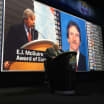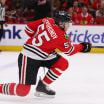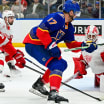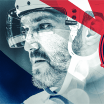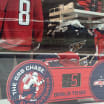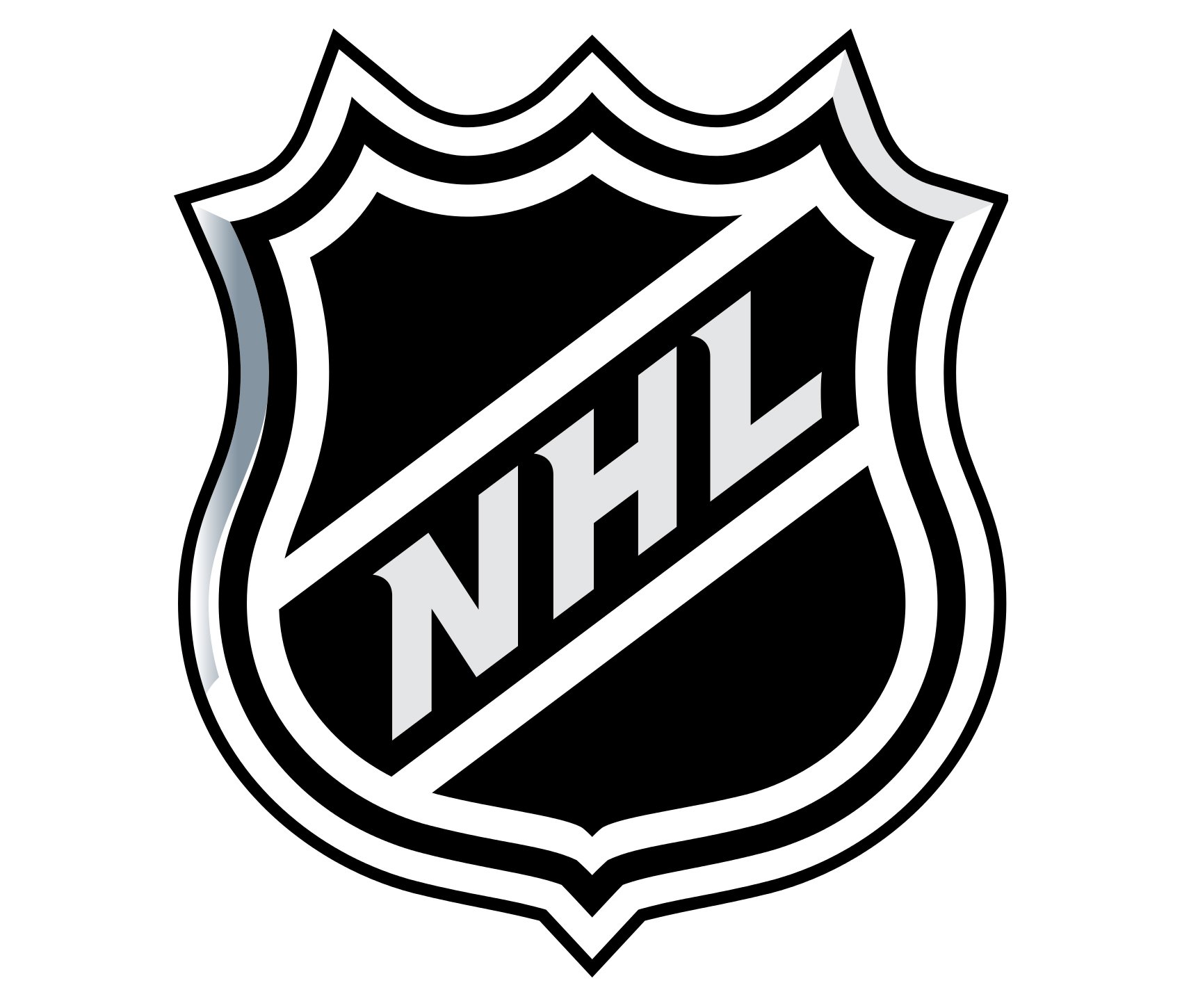With the 2019-20 NHL season on pause due to concerns surrounding the coronavirus, NHL.com will reimagine one NHL Draft each week. Today, we look back at the 2011 NHL Draft, which was held at Xcel Energy Center in St. Paul, Minnesota, on June 24-25, 2011.
2011 NHL Redraft: Kucherov goes from late second round to No. 1
Gaudreau jumps 100 spots to No. 4; two goalies taken among top six picks
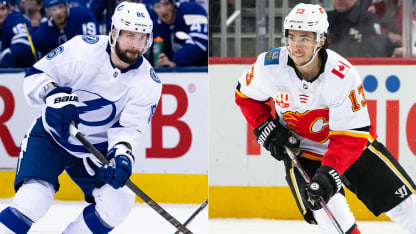
It's hard to believe that 57 other players, including 35 forwards, were selected ahead of Nikita Kucherov in the 2011 NHL Draft, but that's exactly what happened.
The Tampa Bay Lightning, who selected Vladislav Namestnikov with the 27th pick in the first round, were able to get Kucherov late in the second round, and he's been the steal of the draft. Kucherov has 117 more points than the next-closest player in the 2011 class.
Kucherov wasn't the only big-time steal of the 2011 draft; the Calgary Flames were able to select forward Johnny Gaudreau with pick No. 104. In our NHL.com redraft, each landed in the top five, with Kucherov moving all the way up to No. 1.
Who else would move up? Who would drop? Thirty NHL.com staffers, using the draft order and class from 2010, and selected in random order, have answered those questions. Here are the results. For reference, here is how the original draft went.
1. Nikita Kucherov, RW, Edmonton Oilers (originally selected No. 58 by Tampa Bay Lightning) -- The top of this draft was loaded, but Kucherov was a no-brainer here. Take out the growing pains of his first NHL season (18 points in 52 games), and he has consistently been among the most prolific point producers in the NHL, regardless of draft year. Kucherov has 547 points (221 goals, 326 assists) in 515 games, a higher points-per-game average than all but four players since he entered the NHL in 2013-14 (Edmonton Oilers center Connor McDavid, 1.34; Pittsburgh Penguins centers Sidney Crosby, 1.16, and Evgeni Malkin, 1.15; and Chicago Blackhawks left wing Patrick Kane, 1.13). He is also the only player from the 2011 draft to reach 200 goals. -- Shawn P. Roarke, Senior Director of Editorial
2. Mark Scheifele, C, Colorado Avalanche (No. 7 by Winnipeg Jets) -- It was a tad too early to go with a franchise goalie (John Gibson) with a franchise center remaining on the board, so Scheifele was the can't-miss selection. A proven leader with an incredible work ethic, Scheifele ranks in the top five among players chosen in the 2011 draft with 180 goals (third), 264 assists (fifth), 444 points (fourth), 333 even-strength points (second), 49 power-play goals (fourth) and 391 takeaways (third). He's also second in total face-offs (8,809) and third in face-off wins (4,003). He has scored at least 20 goals and 60 points in five consecutive seasons. -- Mike G. Morreale, staff writer
3. Gabriel Landeskog, LW, Florida Panthers (No. 2 by Colorado Avalanche) -- Although it was tempting to go with the scintillating Johnny Gaudreau, the Florida Panthers instead opted for the steady power of Landeskog. The forward was named captain of the Avalanche before the 2012-13 season, his second in the NHL, and could have played that role in Florida instead of an end-of-his-career Ed Jovanovski. Landeskog is second behind Kucherov in goals (198) and points (460) in the 2011 class (460), and his 633 games are second behind Sean Couturier's 647. He's exactly the kind of player you want to lead your team. -- Amalie Benjamin, staff writer
4. Johnny Gaudreau, LW, New Jersey Devils (No. 104 by Calgary Flames) -- Too perfect a fit to pass up Gaudreau, the New Jersey kid selected by New Jersey's team. What really made this a great pick for the Devils is that they got a dynamic player who is second in this draft class behind Kucherov with an average of 0.96 points per game (445 points in 464 games) and with 294 assists. Gaudreau, who had an NHL career-high 99 points (36 goals, 63 assists) last season, would have ably taken the baton from Patrik Elias as the next great Devils forward. -- Jim Cerny, senior editor
5. Jordan Binnington, G, New York Islanders (No. 88 by St. Louis Blues) -- You can argue there wasn't a more valuable player in the NHL last season than Binnington, who in my opinion should have been voted the winner of the Hart (MVP), Vezina (best goalie) and Calder (rookie of the year) trophies. A virtual unknown until he was called up by the Blues on Jan. 5, 2019, he proved just how wrong everyone was about him by going 24-5-1 with a 1.89 goals-against average (first in the NHL; minimum 30 starts) and .927 save percentage (tied for third) to carry St. Louis from last place in the League standings to third in the Central Division, one point behind the Nashville Predators for first place. The confidence and composure he displayed in the regular season never wavered in the Stanley Cup Playoffs, and he helped the Blues win the Cup for the first time in their 51-season history by making 32 saves in a 4-1 win in Game 7 of the Cup Final against the Boston Bruins. Binnington may have been doubted before, but not now, making him the easy selection at No. 5. -- Brett Amadon, staff writer

Video Player is loading.
Current Time 0:00
/
Duration 0:00
Loaded: 0%
0:00
Stream Type LIVE
Remaining Time -0:00
1x
- Chapters
- descriptions off, selected
- captions settings, opens captions settings dialog
- captions off, selected
- Unknown Captions
This is a modal window.
Beginning of dialog window. Escape will cancel and close the window.
End of dialog window.
This is a modal window. This modal can be closed by pressing the Escape key or activating the close button.
STL@BOS, Gm7: Binnington dazzles in Game 7 victory
6. John Gibson, G, Ottawa Senators (No. 39 by Anaheim Ducks) -- Although Binnington won the Stanley Cup after finally making it to the NHL with the Blues last season, Gibson is the more established goalie and was the perfect player for the Senators to build around. Gibson is tops among goalies drafted in 2011 with 139 wins and 287 games. His .918 career save percentage is not only best among goalies in the 2011 class, but it is tied for eighth in the NHL since he entered the League in 2013-14 (minimum 75 games). -- Tom Gulitti, staff writer
7. Sean Couturier, C, Winnipeg Jets (No. 8 by Philadelphia Flyers) -- With Scheifele, selected here by Winnipeg in 2011, already off the board in this redraft, it was an easy choice to give the Jets another top center. Couturier, who has great size (6-foot-3, 211 pounds), is seventh among players in the 2011 class with 402 points (156 goals, 246 assists). He's become more productive in recent seasons too, with an NHL career high of 76 points in 2017-18 (31 goals, 45 assists) and again in 2018-19 (33 goals, 43 assists). With an NHL career face-off winning percentage of 51.5 percent, he leads the League this season at 59.6 percent (minimum 500 draws). Couturier would have been an outstanding choice to keep the Jets strong down the middle. -- Tracey Myers, staff writer
8. Brandon Saad, LW, Philadelphia Flyers (No. 43 by Chicago Blackhawks) -- What's not to like about a kid who once told his teacher that he didn't need to study because he was bound for an NHL career? Saad was strong enough out of the gate to finish third in Calder Trophy voting in 2012-13 (27 points in 46 games), and he'd guzzle from hockey's holy grail following Chicago's second championship in four seasons after having shared the postseason rookie scoring lead with three others with six points (one goal, five assists) in 23 games. Saad ranks fifth in the 2011 draft class in goals (169), 12th in assists (178) and ninth in points (328). He's a great skater with good size (6-1, 206), a versatile two-way player with special-teams strength. Sorry to erase his 2013 and 2015 championships with Chicago, but he's going to Philly. -- Dave Stubbs, columnist
9. Mika Zibanejad, C, Boston Bruins (No. 6 by Ottawa Senators) -- I wasn't sure if I should send a note to thank Dave before or after I took Zibanejad. Somehow, in this redraft, Zibanejad fell three spots from where he originally was selected, so he was an absolute steal. He's fourth in goals (176) and eighth in points (384) among players drafted in 2011, and he's just getting started. Need proof? Since the 2017-18 season, his 98 goals are second only to Kucherov's 113 in the 2011 class. Did the Bruins need a center in 2011? Maybe not, but this is a case of taking the best player available, and with the way he's going now for the New York Rangers, it wasn't even close. -- Bill Price, Editor-in-Chief

Video Player is loading.
Current Time 0:00
/
Duration 0:00
Loaded: 0%
0:00
Stream Type LIVE
Remaining Time -0:00
1x
- Chapters
- descriptions off, selected
- captions settings, opens captions settings dialog
- captions off, selected
- Unknown Captions
This is a modal window.
Beginning of dialog window. Escape will cancel and close the window.
End of dialog window.
This is a modal window. This modal can be closed by pressing the Escape key or activating the close button.
WSH@NYR: Zibanejad scores five goals, OT winner
10. Jonathan Huberdeau, LW, Minnesota Wild (No. 3 by Florida Panthers) -- I'm sorry, Bill, but if anyone can talk about a steal, I'm pretty sure it's me. Huberdeau's 437 points (148 goals, 239 assists) in 536 games are sixth in this draft class. He needed some time to get going, but it seems like he's getting close to his peak, and that's not good news for the other 30 NHL teams. When the season was paused, he was on his way to his second consecutive season of at least 90 points for Florida after he had NHL career highs of 30 goals, 62 assists and 92 points in 2018-19. He has scored at least 20 goals in four of five seasons since 2015-16, the only exception being 2016-17, when he was limited to 31 games because of a cut to his left ankle that kept him out nearly four months. -- Guillaume Lepage, staff writer, LNH.com
11. Ryan Nugent-Hopkins, C, Colorado Avalanche (No. 1 by Edmonton Oilers) -- Earlier goalie panic and hot takes put the Avalanche in the enviable position to select Nugent-Hopkins this far down in the first round. He has played nine seasons for Edmonton -- yes, all of them since his draft day -- and is fifth in points (443) in the 2011 class. He's also been durable, with the third-most games (604) behind Couturier and Landeskog. Nugent-Hopkins can play center or wing, and he's a smart penalty killer and a fine playmaker on the power play. Who doesn't need a cerebral player with that kind of versatility? Quality top-six centers are hard to find, so with nearly nine years of hindsight, Colorado felt fortunate to have found one this late. -- Tim Campbell, staff writer
12. Dougie Hamilton, D, Carolina Hurricanes (No. 9 by Boston Bruins) -- NHL teams covet right-handed puck-moving defensemen, which is why the Hurricanes would've been ecstatic to select the defenseman who eventually ended up with them anyway. Hamilton's 96 goals, 203 assists and 299 points lead defensemen in the 2011 class, and he ranks sixth in games (552) and rating (plus-52) among all players from that draft. Hamilton is durable, has size (6-6, 229) and a booming slap shot, and can play in all situations, making him the obvious choice as first D-man off the board. -- Pat Pickens, staff writer
13. J.T. Miller, C, Calgary Flames (No. 15 by New York Rangers) -- Forwards William Karlsson and Ondrej Palat were serious considerations here, but the chance to take a center with the coveted combination of hustle and muscle was too good to pass up. Pushback down the middle has long been a key for the Flames, dating to the heated Battle of Alberta in the 1980s when hulking Joel Otto (6-4, 220) was effective going head-to-head against the Oilers' Mark Messier. Miller (6-1, 218) brings size and productivity. Of the players available here, only Palat (328) has more points in the NHL than Miller's 309 (122 goals, 187 assists). Another plus for Miller is he's won 52.1 percent of his face-offs in 504 NHL games (1,528 of 2,935). -- Mike Zeisberger, staff writer
14. William Karlsson, C, Dallas Stars (No. 53 by Anaheim Ducks) -- The 2010-11 Stars finished 17th in the NHL in scoring (222 goals; 2.71 per game) and 23rd on the penalty kill (80.1 percent), so picking up a player who could address each of those issues at once was important. Since joining the Vegas Golden Knights for 2017-18, Karlsson has demonstrated a knack for finding the back of the net and a talent for punishing opposing power-play units. He scored an NHL career-high 43 goals in their inaugural season, followed by 24 in 2018-19, and only Bruins forward Brad Marchand (14) has scored more shorthanded points in the NHL than Karlsson (13) over the three seasons. -- John Ciolfi, senior producer, LNH.com
15. Ondrej Palat, LW, New York Rangers (No. 208 by Tampa Bay Lightning) -- Just three players were selected after Palat in 2011. No way that was happening this time. His natural playmaking ability and solid two-way play would have made it easy for him to mesh with pretty much any roster. He has the best rating in the 2011 class (plus-131), even higher than Lightning teammate Kucherov. Tampa Bay has never had fewer than 94 points in a full season with the two of them on its roster (92 at the pause), and though Kucherov is an undoubtedly great player, Palat has had much more to do with that than you might think. -- Dan O'Leary, staff writer

Video Player is loading.
Current Time 0:00
/
Duration 0:00
Loaded: 0%
0:00
Stream Type LIVE
Remaining Time -0:00
1x
- Chapters
- descriptions off, selected
- captions settings, opens captions settings dialog
- captions off, selected
- Unknown Captions
This is a modal window.
Beginning of dialog window. Escape will cancel and close the window.
End of dialog window.
This is a modal window. This modal can be closed by pressing the Escape key or activating the close button.
TBL@TOR: Palat cleans up in front to knot the score
16. Phillip Danault, C, Buffalo Sabres (No. 26 by Chicago Blackhawks) -- At the time of the 2011 draft, the Sabres needed to improve offensively and defensively, and Danault is the kind of player who can provide help at each end of the ice. It took him a few years to get going, but no player in this draft class has a better shot attempts percentage (55.8 percent), and only Boone Jenner (53.9 percent) has been better in the face-off circle than Danault (53.2 percent) among players with at least 500 draws. He quietly has been a productive player, especially considering he gets minimal power-play time (0:46 per game). He is 10th in the class in even-strength points since 2016-17 with 149 (44 goals, 105 assists) in 286 games. The Sabres may have just landed a future Selke Trophy winner (best defensive forward in NHL). -- Sebastien Deschambault, managing editor, LNH.com
17. Vincent Trocheck, C, Montreal Canadiens (No. 64 by Florida Panthers) -- Montreal, which finished 22nd in the NHL in scoring in 2010-11 (213 goals; 2.60 per game), got some much-needed help in that department when they selected Trocheck, who is 13th in the 2011 class with 284 points (112 goals, 172 assists) in 427 games, 10th in power-play points with 74 (25 goals, 49 assists) and 14th in even-strength points with 201 (80 goals, 121 assists). Trocheck has also made opposing power plays pay with seven shorthanded goals, fourth most among players drafted in 2011. -- William Douglas, staff writer
18. Rickard Rakell, LW, Chicago Blackhawks (No. 30 by Anaheim Ducks) -- A season removed from winning the Stanley Cup for the first time since 1961, the Blackhawks went with Rakell, perhaps envisioning him on a potent first line with two 22-year-olds who already had made their mark in the NHL, Jonathan Toews and Patrick Kane. Indeed, Rakell has displayed offensive chops in his eight NHL seasons with 283 points (129 goals, 154 points) in 447 games, including back-to-back seasons with at least 33 goals (2016-18). He brings value on the power play (71 points; 28 goals, 43 assists) and has shown an ability to come through in the clutch with 25 game-winning goals, seventh among players in the 2011 class. -- Barry Rubinstein, manager, assignments
19. Ryan Strome, C, Edmonton Oilers (No. 5 by New York Islanders) -- Having already selected Kucherov at No. 1 in this redraft, adding Strome gives Edmonton a strong two-way center who can play in all situations. His average of 0.52 points per game is 16th in the 2011 draft class, but he may have just started to find his scoring touch with the Rangers this season. Strome already had matched his NHL career high of 18 goals (also 2018-19) and set a new high with 59 points in 70 games before the season was paused. He has been a perfect complementary player on a line with Artemi Panarin, a role he could have had for the Oilers with Kucherov (redraft) or Taylor Hall (real draft). -- Matt Cubeta, Editor-in-Chief, NHL.com International
20. Jean-Gabriel Pageau, C, Phoenix Coyotes (No. 96 by Ottawa Senators) -- Even with Ryan Dzingel, Andrew Shaw and Oscar Klefbom available, the Coyotes went with the center who can defend, play up and down the lineup, and kill penalties. Improving the PK was something Phoenix needed badly, having finished 26th in the NHL in 2010-11 (78.4 percent). In 2015-16, Pageau led the NHL with seven shorthanded goals, and his 13 shorthanded goals and 20 shorthanded points lead players from the 2011 draft. Somewhat of a late bloomer, he seems to be hitting his stride offensively this season with an NHL career-high 26 goals in 67 games for the Senators and Islanders. Pageau's offensive production can be streaky but also very clutch, as evidenced by his two playoff hat tricks, including a four-goal game for the Senators against the Rangers in the 2017 Eastern Conference Second Round. -- Paul Strizhevsky, columnist, NHL.com/ru
21. Oscar Klefbom, D, Ottawa Senators (No. 19 by Edmonton Oilers) -- This deep in the redraft, only one defenseman was off the board, so it seemed like a good spot for the Senators to add depth at the position. And with Erik Karlsson coming off his second NHL season at that point, it inspired them to add another Sweden-born defenseman with offensive ability. Klefbom ranks second to Hamilton among defensemen from the 2011 draft in goals (34), assists (122) and points (156), even though he ranks sixth in games (378). -- Nick Cotsonika, columnist
22. Boone Jenner, C, Toronto Maple Leafs (No. 37 by Columbus Blue Jackets) -- The Maple Leafs added another skilled forward to their arsenal with the selection of Jenner, who scored 30 goals as a 22-year-old in 2015-16 but has also shown an ability and willingness to play a shutdown role. Jenner has also provided durability; he has played at least 75 games the past four seasons. A jack-of-all trades center who can play a bottom-six role is the perfect fit for Toronto. -- Brian Compton, deputy managing editor

Video Player is loading.
Current Time 0:00
/
Duration 0:00
Loaded: 0%
0:00
Stream Type LIVE
Remaining Time -0:00
1x
- Chapters
- descriptions off, selected
- captions settings, opens captions settings dialog
- captions off, selected
- Unknown Captions
This is a modal window.
Beginning of dialog window. Escape will cancel and close the window.
End of dialog window.
This is a modal window. This modal can be closed by pressing the Escape key or activating the close button.
CBJ@NSH: Jenner cleans up Gerbe's rebound in front
23. Andrew Shaw, RW, Pittsburgh Penguins (No. 139 by Chicago Blackhawks) -- With elite forwards Crosby and Malkin each still in his prime two years after Pittsburgh's 2009 Stanley Cup championship, the Penguins needed role players who were willing to do a lot of the grunt work while still contributing offensively. Shaw would have been an excellent fit. He is 12th in the 2011 class with 114 goals -- a lot of them scored because he was willing to go to the dirty areas in front of the net -- and first with 567 penalty minutes. -- John Kreiser, managing editor
24. Blake Coleman, C, Ottawa Senators (No. 75 by New Jersey Devils) -- Coleman's high energy was among the intangibles that convinced the Senators to take him. His relentless play on the defensive end sets up his offense. His competitive drive was attractive to the Senators, along with his affinity to produce while on the penalty kill. Since 2017-18, Coleman leads the 2011 class with nine shorthanded goals, and his 12 shorthanded points are second to William Karlsson's 13. -- Jon Lane, staff writer
25. Jonas Brodin, D, Toronto Maple Leafs (No. 10. by Minnesota Wild) -- Having just drafted a center three picks ago in this redraft, the Maple Leafs opted for a defenseman here. The choice was between Brodin and Adam Larsson, who was the No. 4 pick and the first defenseman selected in 2011. Brodin, the third defenseman taken in this redraft, ranks first at the position in this draft class in games (555), second in rating (plus-47) and third in goals (30), assists (116), and points (146). He's also second in blocked shots (890) behind Larsson (931) and should help the Maple Leafs defensively. -- David Satriano, staff writer
26. Josh Manson, D, Chicago Blackhawks (No. 160 by Anaheim Ducks) -- The Blackhawks improved offensively by taking Rakell with the No. 18 pick in this redraft, and this was an opportunity to improve defensively. Manson is a strong, modern-day second-pair defenseman in that he moves the puck well and can get up the ice but also can shut down the opposition in the defensive zone and play physical. He can produce, as he did with an NHL career-high 37 points (seven goals, 30 assists) in 2017-18, but his responsible play with and without the puck, his physical edge, and the fact that you can pencil him in for 20 hard minutes per game are more his calling cards. -- Dan Rosen, senior writer
27. Joel Armia, RW, Tampa Bay Lightning (No. 16 by Buffalo Sabres) -- With the pick they used on Namestnikov in 2011, the Lightning got a much more complete player in this redraft when Armia fell 11 spots from his original position. Armia's offensive maturation, high shot volume and physicality helped him provide the Canadiens with some of the best category coverage in the NHL when healthy before the season was paused. Despite being limited to 58 of Montreal's 71 games, Armia set NHL career highs in goals (16), points (30) and shots on goal (155), and he is one of four players in the NHL averaging at least 2.50 SOG (2.67) and 2.50 hits (2.52) per game (Coleman, Alex Ovechkin, Brady Tkachuk). Armia also ranks third in the 2011 draft class in shorthanded points with 13. -- Pete Jensen, senior fantasy editor
28. Joel Edmundson, D, Minnesota Wild (No. 46 by St. Louis Blues) -- Teams need all kinds of players to be successful, and that includes big, crease-clearing, physical defensemen. Edmundson (6-4, 215) provided muscle for the Blues when they won the Stanley Cup last season, leading St. Louis defensemen with 42 hits in 22 postseason games and blocking 36 shots in 16:32 of ice time per game. He's been just as nasty with the Hurricanes this season, leading their defensemen with 118 hits in 18:27 of ice time per game. He also has an NHL career-high 20 points (seven goals, 13 assists) and is plus-7 in 68 games in his first season with Carolina, showing he's got multiple dimensions to his game. -- Adam Kimelman, deputy managing editor
29. Adam Larsson, D, Vancouver Canucks (No. 4 by New Jersey Devils) -- The Canucks won the Presidents' Trophy with 117 points in 2010-11 and advanced to Game 7 of the Stanley Cup Final before losing to the Bruins. Their needs were few, but it would have been hard to pass up Larsson (6-3, 208), a physical defenseman who was NHL-ready as an 18-year-old (18 points in 65 games, 20:37 of ice time per game in 2011-12). Among defensemen from the 2011 draft, he is third in games (547), fourth in points (127; 21 goals, 106 assists) and third in penalty minutes (323). -- Frank Giase, staff writer
30. Ryan Dzingel, C, Anaheim Ducks (No. 204 by Ottawa Senators) -- Dzingel didn't make his NHL debut until Dec. 22, 2015, but the Ducks were deep at forward and could have afforded to wait a few seasons for him to develop. Since the 2015-16 season, Dzingel is 20th in the 2011 class with 167 points (74 goals, 93 assists) in 332 games, including an NHL career-high 56 (26 goals, 30 assists) in 78 games for the Senators and Blue Jackets last season. Dzingel brings some physicality too. His 275 hits are 25th among forwards drafted in 2011 since 2015-16. -- Rob Reese, fantasy editor
